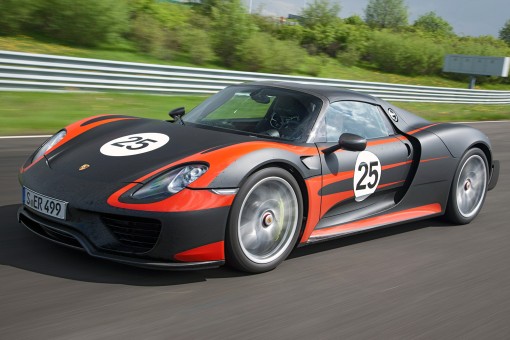Spyder adds to Porsche’s sports car heritage

THE 918 Spyder continues a long tradition of super sports cars at Porsche; as technology platforms, as the driving force behind both car emotion and car evolution.
It follows a long line of superb sports cars of their decades: The 904 Carrera GTS, the Porsche 930 Turbo, the 959, the 911 GT1, the Carrera GT. More than any of its predecessors, the 918 Spyder is providing key impetus for developing technologies for future vehicle concepts. It offers a complete package of components that reflect Porsche DNA — more concentrated than ever before.
It is powered by an innovative 887hp plug-in hybrid power plant which uses pedigree motorsport technology to deliver maximum performance with minimum fuel consumption. The mid-mounted 4.6-litre V8 engine is coupled with two electric motors with lithium-ion batteries combine to deliver 0-62 mph in 2.8 secs, 211 mph top speed, plus approx. 85 mpg and 79 g/km CO2.
And it sticks like glue wherever you point it thanks to independent all-wheel-drive.
Developing the car from scratch with a clean sheet of paper allowed Porsche engineers to come up with a no-compromise concept. The entire car was designed around the hybrid drive. The 918 Spyder therefore demonstrates the potential of the hybrid drive to a degree never before seen: The parallel improvement of both efficiency and performance without one being at the cost of the other. This is the idea that has made the Porsche 911 the most successful sports car in the world for 50 years. In short, the 918 Spyder will act as the gene pool for the Porsche sports cars of the future.
The 918 Spyder reveals its close links to motorsport in a variety of ways. It has been designed, developed and produced by Porsche engineers who build race cars, in co-operation with series production specialists. A great deal of insight gained from the development of Porsche race cars for the Le Mans 24 hours in 2014 is thus integrated into the 918 Spyder — and vice versa.
The structural concept of the 918 Spyder with a rolling chassis as its basis – a basic vehicle that can be driven even without a body – is race car tradition at Porsche. The concept of the V8 engine originates from the LMP2 RS Spyder race car. The load-bearing structures, the monocoque and subframe, are made of carbon fibre reinforced polymer (CFRP). Porsche has many years of experience with this high strength, lightweight construction material and has again achieved top results with the development of the series production 918 Spyder. Many parts of the super sports car come from manufacturers who have a proven record as suppliers for motorsport vehicles.
A key message of the 918 Spyder is that the hybrid drive from Porsche is a plus for no-compromise driving dynamics. Drivers can experience this thanks to the unique all-wheel drive concept with a combination of combustion engine and electric motor on the rear axle and the second electric motor on the front axle.
It is based on knowledge gained by Porsche racing the successful 911 GT3 R Hybrid. Due to the additional, individually controllable front drive, new driving strategies for extremely high, safe cornering speeds can be implemented. Furthermore, the advanced ‘boost’ strategy manages the energy of the electric drive so intelligently that for every sprint with maximum acceleration, the full power of the 918 Spyder can be tapped into simply by fully pressing the accelerator down. In short, the 918 Spyder allows all drivers to experience the potential of advanced longitudinal and transverse dynamics.
An even more important factor is that the 918 Spyder surpasses previous models and competitors by far in its efficiency as well. As a plug-in hybrid vehicle, it systematically combines the dynamic performance of a racing machine with over 880hp and low NEDC fuel consumption, which at about three litres fuel per 100 km is better than that of most small cars today. To sum it up, maximum driving fun with minimal fuel consumption.
The multi-link chassis is inspired by motorsport design, complemented by additional systems such as the Porsche Active Suspension Management (PASM) adaptive shock absorber system and rear-axle steering. This incorporates an electro-mechanical adjustment system at each rear wheel. The adjustment is speed-sensitive and executes steering angles of up to three degrees in each direction. The rear axle can therefore be steered in the same direction as the front wheels or in opposition to them. At low speeds, the system steers the rear wheels in a direction opposite to that of the front wheels. This makes cornering even more direct, faster and more precise, and it reduces the turning circle. At higher speeds, the system steers the rear wheels in the same direction as the front wheels. This significantly improves the stability of the rear end when changing lanes quickly. The result is very secure and stable handling.
http://www.porsche.com/microsite/intelligent-performance/usa.aspx
